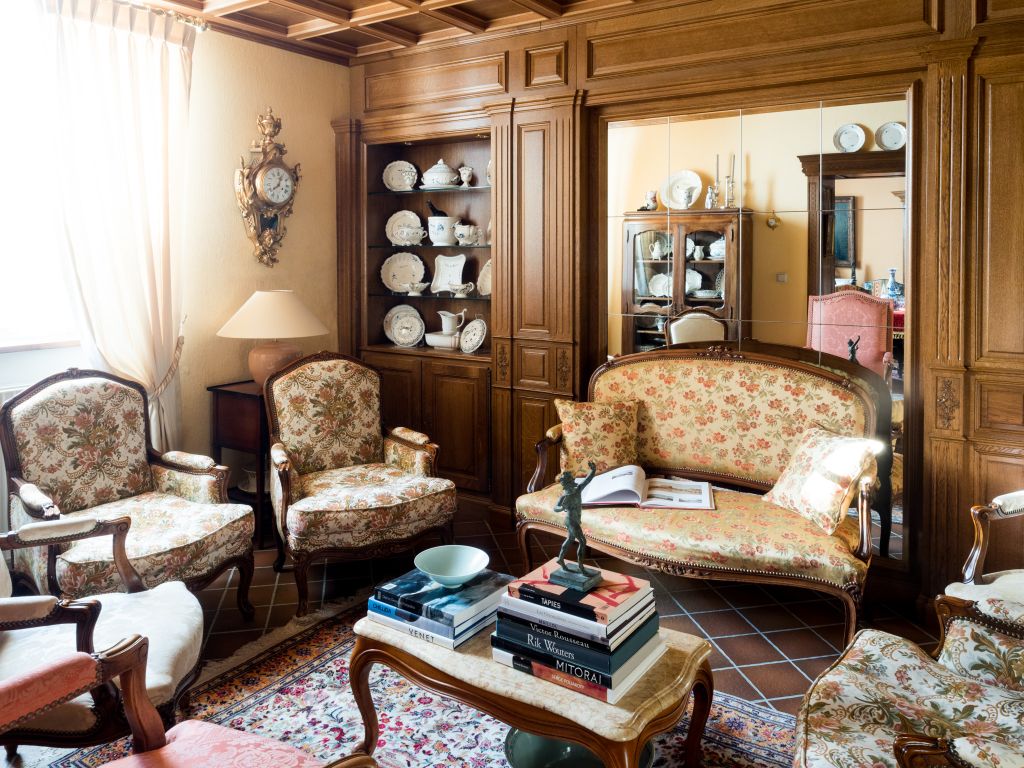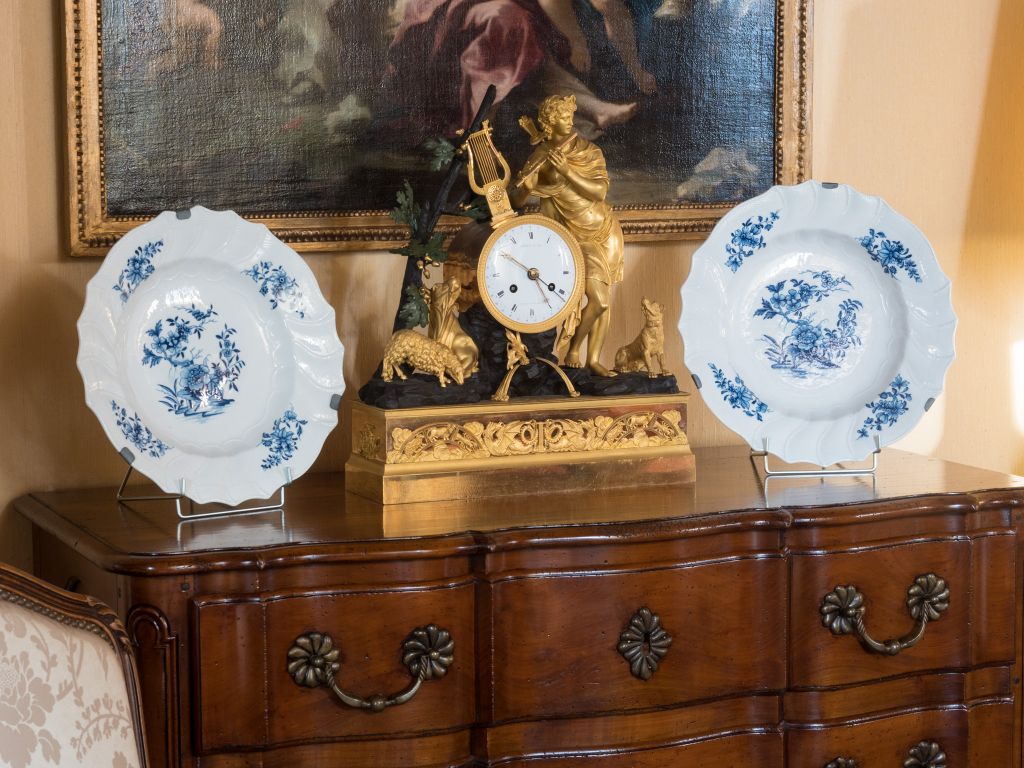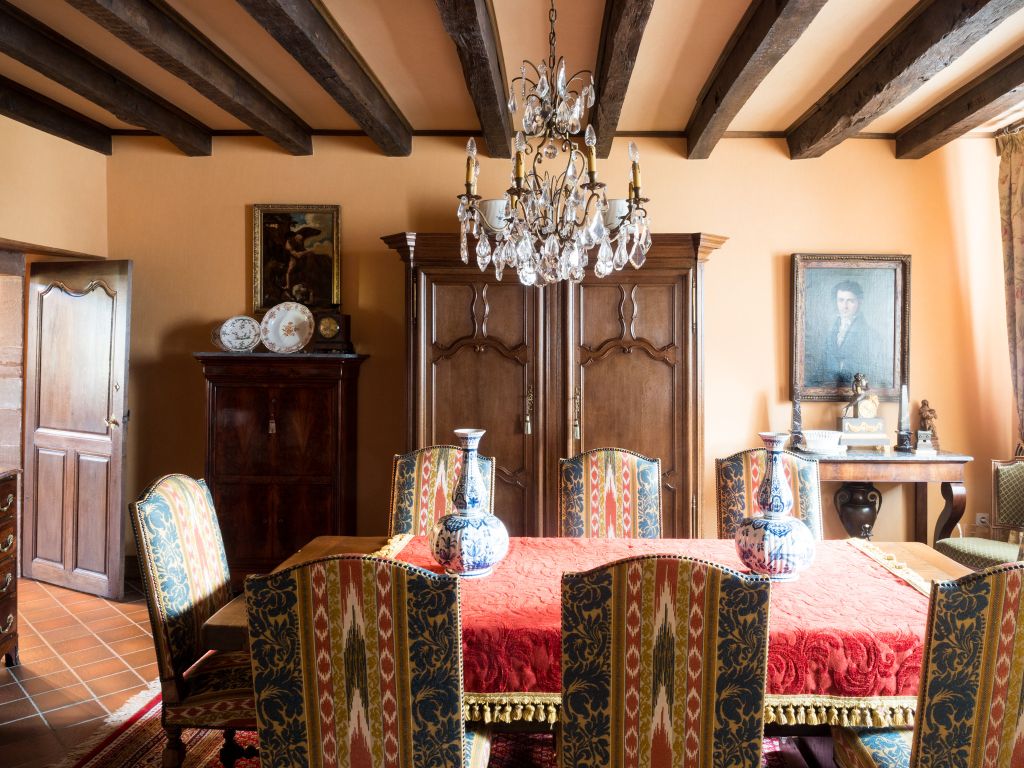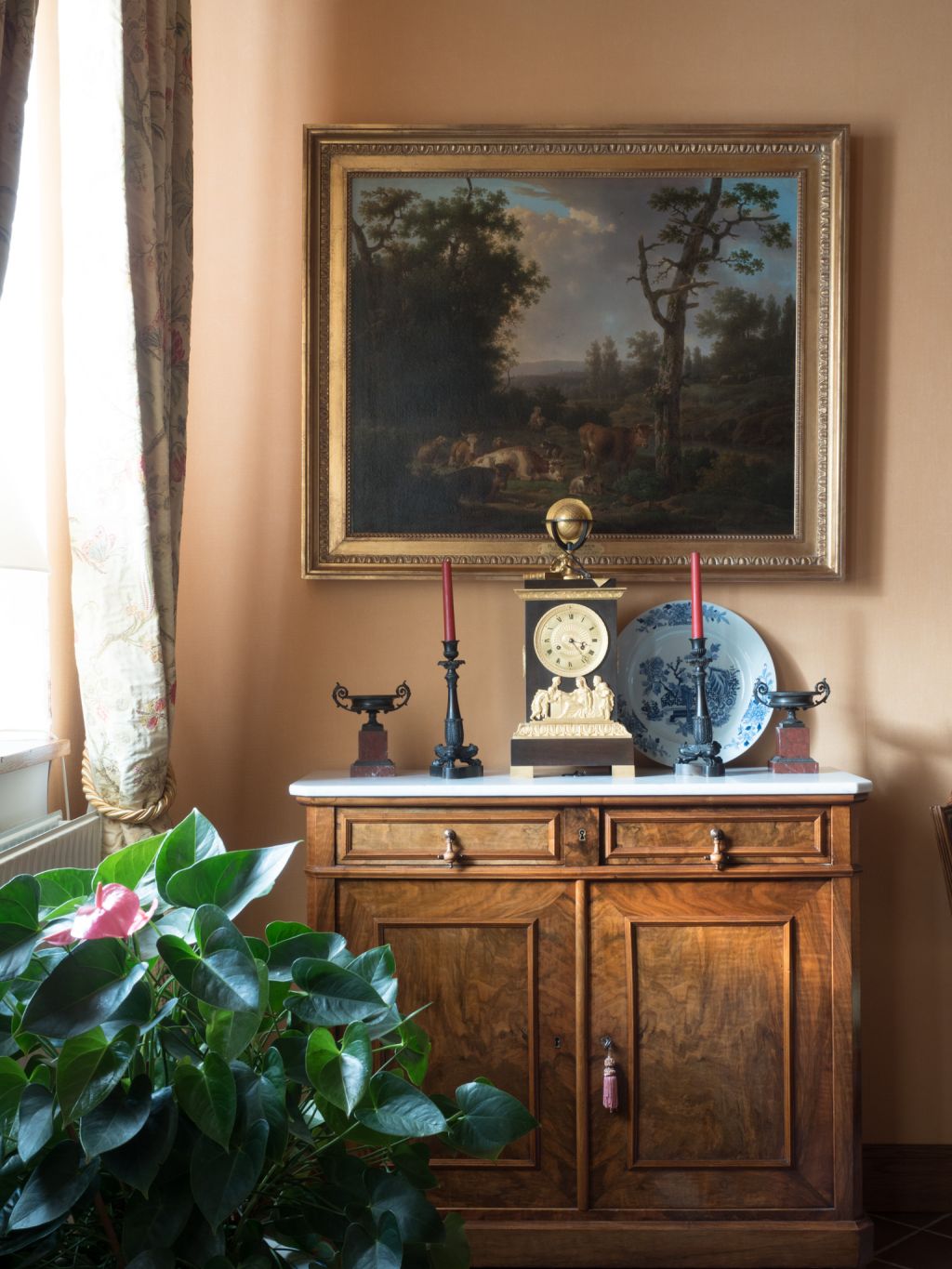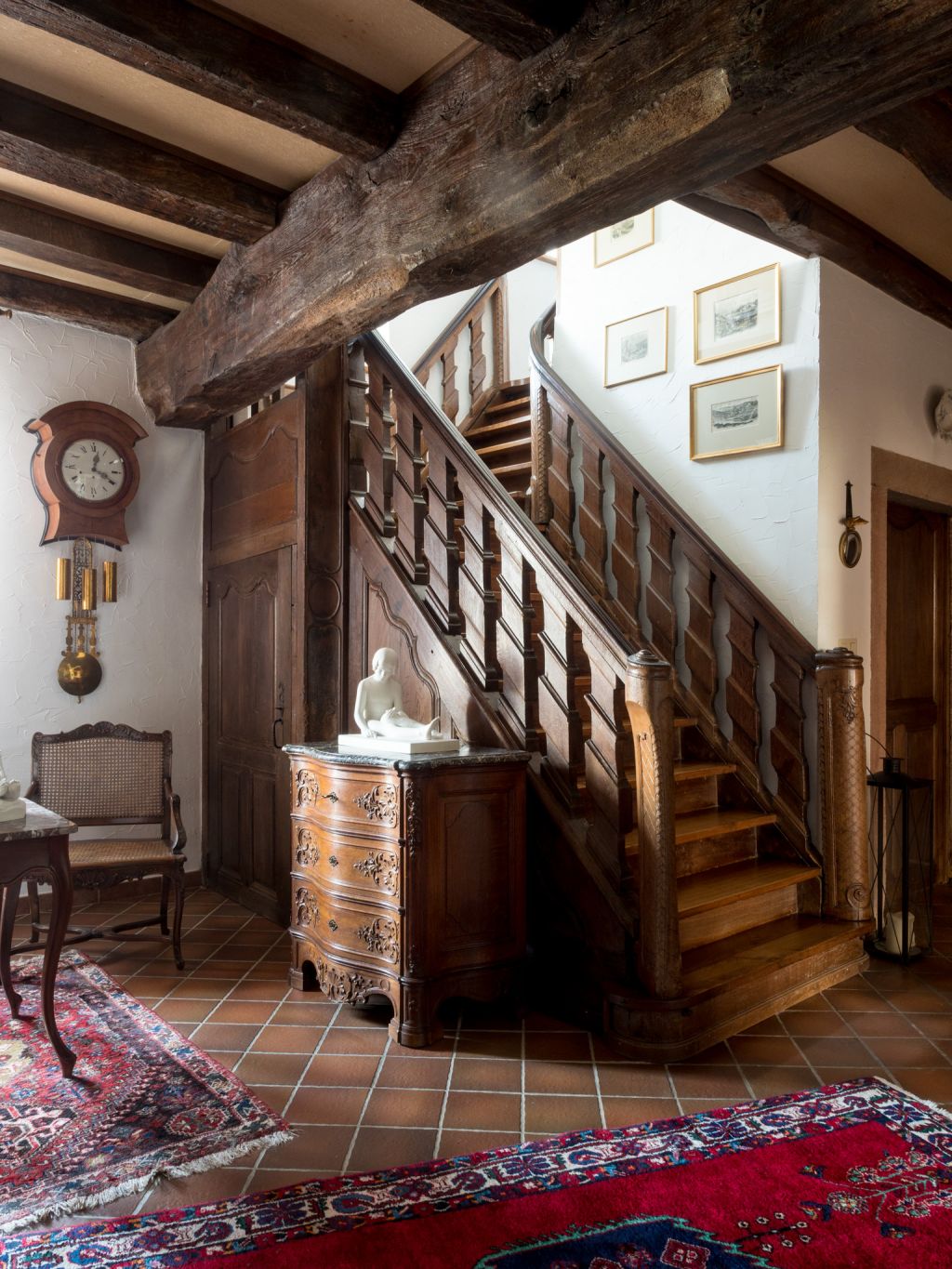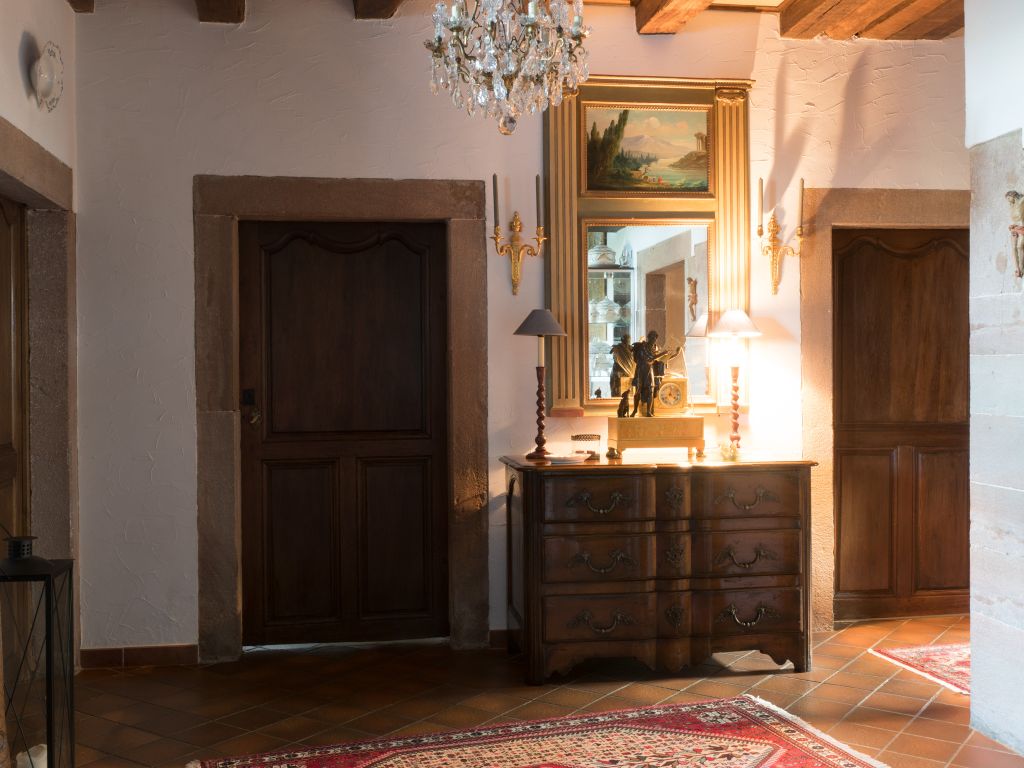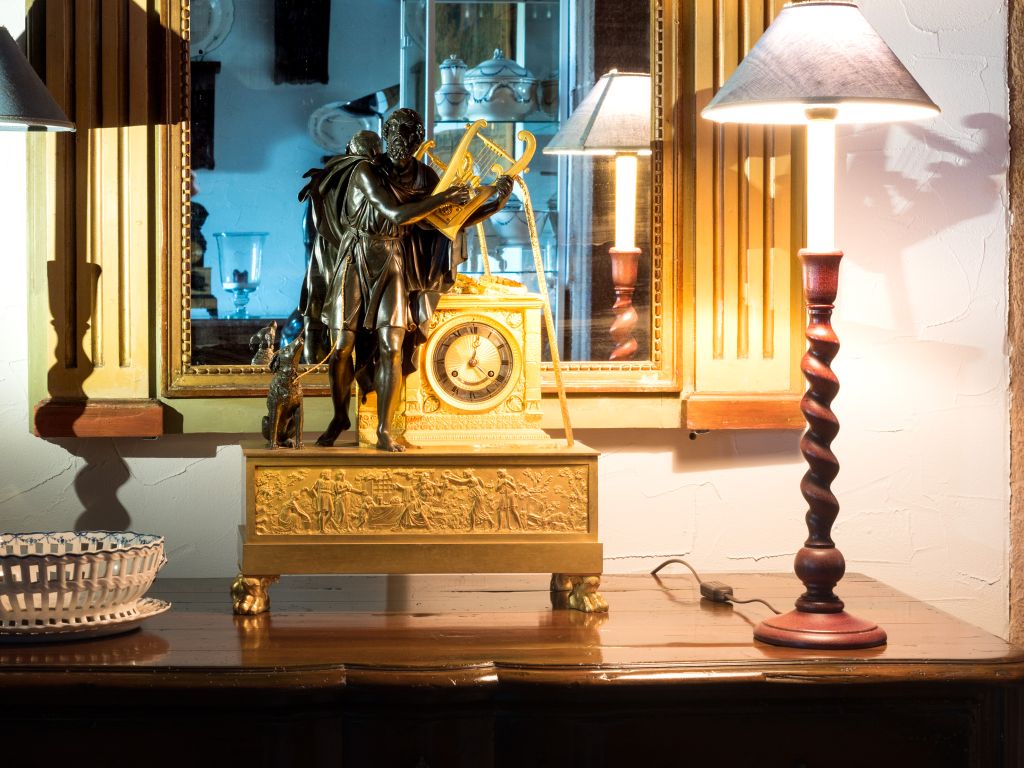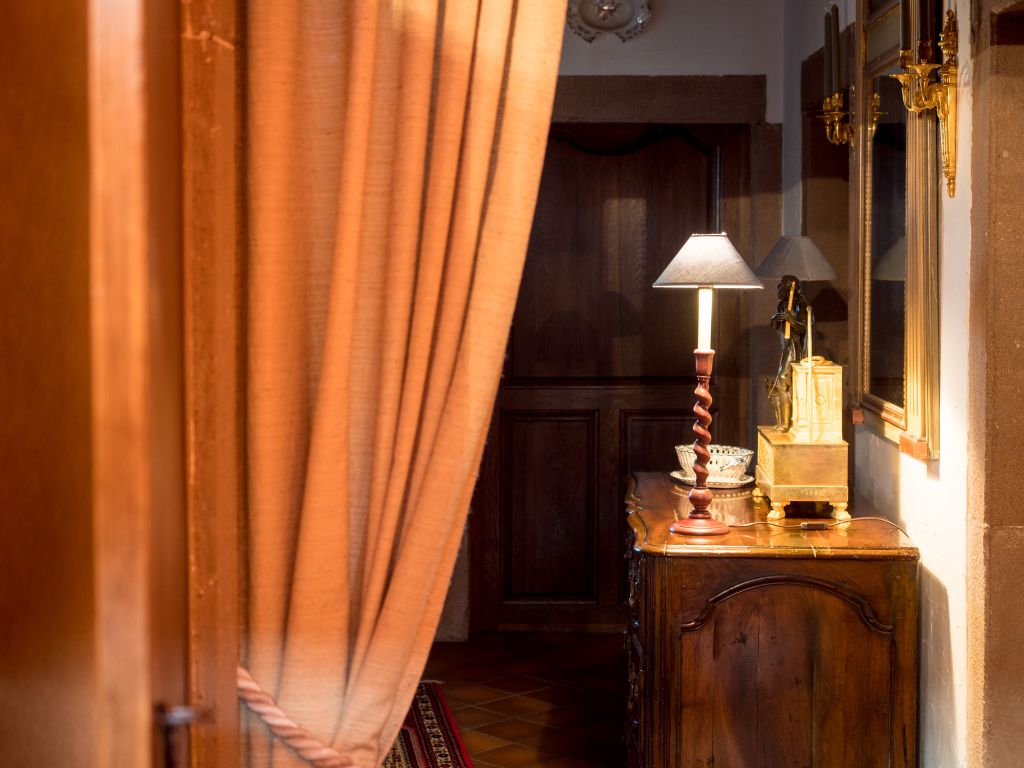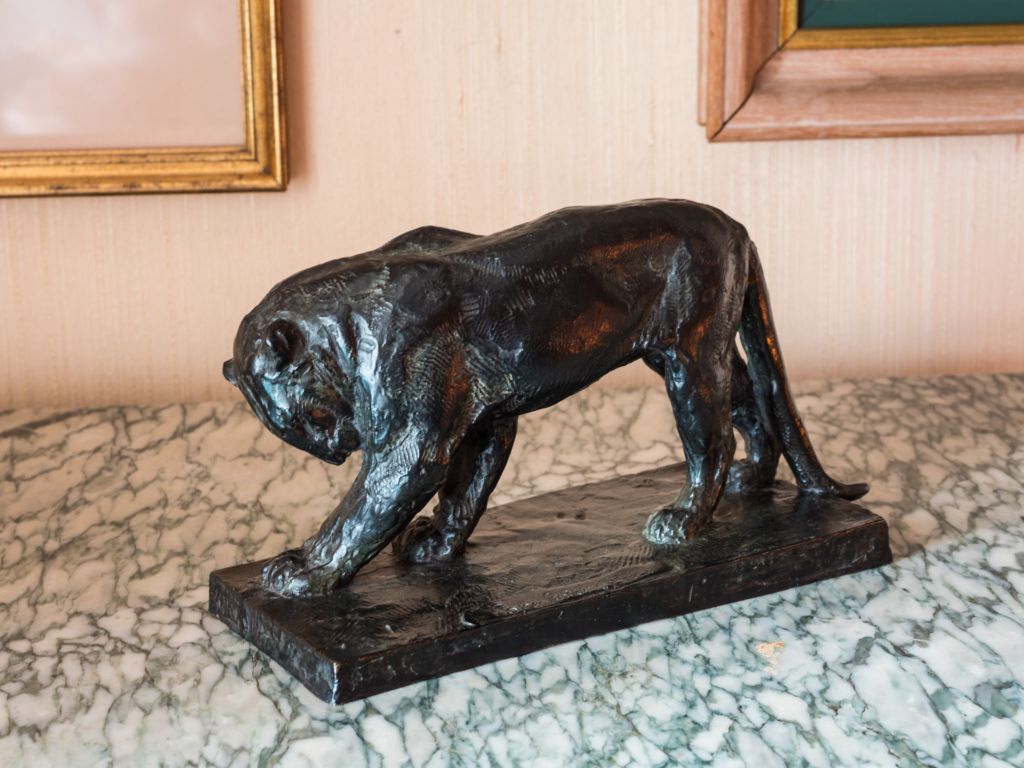Josette and Guy
A journey down memory lane
Josette and Guy welcome us to their two-hundred-year-old family home, rich in character and architecture.
Pull back the curtain and you'll discover a cosy setting, full of softness and serenity.
Josette and Guy are a couple with a passion for art and history, and their home is a precious (jewel case) universe in which each object tells a story, while interacting with the others to create harmonious atmospheres. With its period furniture, warm wood panelling, discreet and subtle drapes, subdued lighting and fined art objects, the couple's home is a veritable piece of architectural heritage. But there's no desire to make the objects into museum pieces - on the contrary, the important thing is to bring them to life on a daily basis! Interview with Guy Biver.
Wunnen: What is the history of this house?
Guy Biver: This house is the cradle of my ancestors, preserved from generation to generation. Typical of the region, it's an early 19th century farmhouse, with a stable, barn and sheepfold, built on a family estate. The property came into the family over 300 years ago. A former roadway, dependent on the local seigneury, it is mentioned as early as 1611. Its tenants were servile until 1782. Thanks to the family papers - the oldest documents date from the end of the 17th century - it is possible to retrace the journey through the centuries, with all its ups and downs.
The joy of living in a beloved place that was beloved in the past, is beloved in the present and, I dare say, will be beloved in the future.
Has the house undergone many changes over the years?
When I bought the house, it was in a sorry state. The interior and exterior were still representative of its time. Although it had undergone a few changes over its many years of life, these were almost imperceptible and remained in keeping with the original architecture (without an architect!).
After two years and mountains of work, the house has been given a new lease of life. We didn't go too far with the renovation so as not to alter the character of the whole. We didn't want to touch the proportions of the spaces.
How long have you lived here?
My wife and I moved here after we got married in 1981.
It's a family home. You represent the 12th generation. When you look at these walls, it's like leafing through a book...
In this family home, where each generation has left its mark, there's something very special, something different, something inexplicable. The memory of the place has taken hold of us. It's a dimension, a charm, an atmosphere, a sense of continuity, of tradition, the joy of living in a beloved place that was beloved in the past, is beloved in the present and, I dare say, will be beloved in the future.
What are the advantages of living in an old house as opposed to a contemporary one?
All houses are ideal when the architecture and layout are harmonious. Several factors are essential: sufficient space, serenity, comfort and functionality. I think that our centuries-old country house, which has remained authentic, where we really live, combines respect for the old with modern dynamism. It's not a museum; we want to keep it very much alive. I'm alarmed by the lack of charm of urban sprawl, with its charmless housing estates and stereotyped, transparent homes with minimalist furnishings.
Combining the past with the present
You cultivate another passion in addition to traditional architecture, that of antique furniture and objects, collectors' items, paintings...
It could be that a taste for beauty is in the genes! Personally, I don't think that a passion for anything with 'soul' is innate. You're not born an aesthete, you become one! All you have to do is learn to recognise different styles and eras, and understand how they have evolved. Immerse yourself in as many specialist books as possible, go to museums and galleries, examine and compare... By dint of this work alone, you will sharpen your sense of beauty and develop your sensitivity and ability to judge.
Which periods and styles are of particular interest to you?
I'm particularly interested in the period around the turn of the eighteenth and nineteenth centuries. For me, neoclassicism and post-neoclassicism represent one of the golden ages of architecture and art, corresponding to the Louis XVI and Empire styles, with the Directoire style coming in between. The upheavals at every level - political, economic, societal and artistic - led to a new modernity and new expressions.
What impact does this antique furniture have on your everyday life?
We live in a perfect symbiosis between the old and the new. Antique furniture has an entirely different function in our homes, one that's neither static nor museum-like. We make use of it, we use it regularly. Of course, we attach great importance to their decorative value. Our philosophy is that it must always be possible to verify the reason why objects were made; a piece of furniture must still be usable today. What's more, for me there is no greater pleasure than rescuing a neglected object from oblivion, restoring it to its former glory tarnished by the vicissitudes of history, discovering how it was made and, through the traces of its life, guessing at a part of its history.
Each piece of antique furniture carries with it the memory of another time, of a forgotten tradition and of the people who used it. My wife and I have each introduced our own world and family memories. Some of them remind us of our youth: they are real memories. Is it possible, for example, to remain insensitive to the beauty of the mechanism of an antique clock, especially when you know that the design of the hidden parts required as much attention as that of the case? Of course, these objects may not have the same significance for everyone, but they reveal the taste and show the true personality of their owner.
Objects with heart
If you had to take just one piece of furniture/object to a desert island, what would it be?
First and foremost, I'd take my surfboard! I'd also be delighted to be able to take my "protégée" with me, a bronze panther with a very elegant shape by Roger Godchaux, one of the best animal sculptors of the 20th century.
As an enthusiast and amateur, how much expertise do you need to identify authentic pieces?
Authenticity is under increasing threat. I am firmly convinced that no collector or enthusiast is immune to error and deception. Recent cases show that even experts allow themselves to be deceived at the highest level. Remember the case of the fake chairs acquired by the Palace of Versailles for astronomical prices, when in fact they were recent counterfeits. Some museums are said to be full of fakes! Imagine if a true layman wasn't fooled! By observing, feeling, comparing and informing yourself, you'll be able to get a good look and avoid the worst surprises. In the end, you have to make a mistake to grow! (smiles).
How does this passion work within a couple?
My wife has a similar approach to mine. Like me, she's got the antiques bug. The passionate quests in the middle of the jumble of second-hand dealers, as well as the visits to the major antiques fairs (Brafa, Tefaf, Eurantica etc.) are done as a couple. What's more, it's my wife who adds an important decorative dimension to the house: arrangements, colours, hangings... Just as she loves to show off her love of entertaining family and friends.
You have two grown-up children - what do they think of the house they grew up in?
Passionate about the past - as evidenced by their training as art historians - they are equally open to the present. The places of their childhood and youth naturally evoke memories, emotions and adventures. Close ties have been forged over the years. They are aware of both the power of tradition and the obligation of continuity.
When objects come together
How do you arrange the objects in your home, to keep the mood light and harmonious?
Avoid ostentation and objects that clash with the rest of the décor! Decorating a living space always starts with a beautiful object or piece of furniture, around which an atmosphere is created. It's fascinating to mix furniture and objects from different regions and very different periods. This confrontation takes us on a journey from one culture to another, not just in terms of aesthetics, but also in terms of messages born of cross-fertilisation and dialogue. I'm a great believer in eclecticism, and I like the idea of work in progress; an interior design is never set in stone, nor is it settled down to the smallest detail. Like Jean Cocteau, I'm wary of " the prettiest dresses", which he considered to be "taken off".
After decades of passion and collecting, the question of tidying up is certainly becoming crucial...
From the art of tidying up to that of 'disturbing', there is a palette of nuances that constitute more or less ostentatious styles. I'm an inveterate collector, yes, but I'm not a bulimic or an accumulation fetishist. It's true that discoveries expand over time, but the arrangement and organisation evolve just as much. I see myself as an advocate of 'sympathetic' disorder.
The importance of memory
How do you see the future of antique and authentic furniture in general?
The days when rustic and second-rate objects were the pride and joy of antique dealers are definitely over. Neither this type of furniture nor stylish antique furniture is to the taste of the younger generation, who are more enthusiastic about what has become 'vintage' or kitsch. Today's mentality, where everything is endlessly imitated and superficial fashions in interior design follow one another ever more rapidly, has meant that even fine antiques have lost their appeal. The influence of antique dealers in this movement is not insignificant: it is they who anticipate, make and break fashions. Let's hope that current trends will one day be reversed!
We're not the owners in absolute terms, but simply the custodians or passers on of the legacies of history, so that we can enjoy them for a more or less long time
Why do you think it's important to promote and preserve objects that are rich in history?
Antique furniture reflects the art of living and, to put it bluntly, the affirmation of an aesthetic. Witnesses to the passing of the centuries, they establish a link with our past and bear witness to vanished craft techniques. Wouldn't saving these objects be a way of honouring their talented creators? Finally, let's stop being pretentious! Some of our contemporaries, and not the least, have adopted an approach that I would describe as contemptuous of the legacy of their ancestors. These "homines novi", fanatics of so-called fashions, have no qualms about letting what was cherished by previous generations go up in smoke. It's a lack of sensitivity and respect for previous generations, even though finding the money to acquire these goods was often the result of financial acrobatics. How else, for example, can we explain the disposal of several works by a renowned Luxembourg painter in a rubbish tip, and so on?
The importance of preserving an old house like yours? This building certainly resonates in the village ...
I would never wish to be grandiose, but the house, with its location in the centre of the village in a row with other old houses, all of which are listed as protected heritage, must have struck a chord with the Luxembourg painter Joseph Kutter, who chose it as his subject on at least two occasions. Of course, a coherent group of old buildings restored according to the rules of the trade always adds value to a locality. This restored ensemble is often cited as an example and features prominently in publications on rural housing.
Do you think the public authorities could give more support to the preservation of memorabilia?
A complex question! Unfortunately, in many families, memory, knowledge of family traditions and the reflex to sediment and stratify the past are weakening. The "washing away of memory" spares nothing. Worse still, the liquidation of a house is often accompanied by the destruction of everything considered to be of lesser interest and yet so useful to history. In short, the first thing to do is to define what falls under the heading of memorabilia. Documents, works of art, ensembles to be preserved in situ, all of national interest? Support implies financial aid. Let's be clear: all state aid is obviously accompanied by charges and constraints. For example, grants for the restoration of a building are awarded on condition that the work is carried out in accordance with the directives of the body responsible for the built heritage. Similarly, state aid for the preservation of memorabilia could, for example, be accompanied by an obligation to open your house to the public, even if only for a day. Imagine a crowd of onlookers strolling through your home! Another aspect, and here we turn to France, is that certain objects of national remembrance are banned from leaving the country. This radically reduces their 'commercial' value, which is obviously not always to the liking of their owners.
Of course, the public authorities have a major responsibility in the preservation of memorabilia, but we must be careful not to delegate the entire responsibility to the State. That would be an illusion! I believe that the various state institutions, museums, archives, libraries and other documentation centres, currently have dynamic teams working - better than ever - to ensure this preservation.
You don't own your (branded) watch, you look after it for the next generation... Is that how you see your role?
That's a good point. We're not the owners in absolute terms, but simply the custodians or passers on of the legacies of history, so that we can enjoy them for a more or less long time. Of course I fit into this role. Works of art have a long life, but a short stay ! They have belonged to others, and I like to think that they will later be in other hands. But if they are removed from their family or cultural context, they lose their emotional value.
